| In this modern age, and
rightly so, computers dominate many industries,
including printing. They are ideal where standard,
mass produced work is required, such as for
newspapers and books, but there is still a place for
the specialist, who produces smaller quantities of
high quality work for local companies, societies and
institutions. One of
these was John Neave, who specialised in business
documents, such as statements, compliment slips,
labels, leaflets, business cards, and other items
such as posters, programmes, admission and lottery
draw tickets. In fact John must have been one of the
few printers in the West Midlands who still used the
traditional methods. |
|
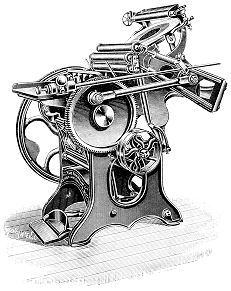
An old Franklin printing machine. |
John’s interest
in printing started at an early age. His father worked
at Hobson’s in Stafford Road, Wolverhampton and when
John attended a works’ Christmas party, he was given a
present consisting of a roulette wheel and a gaming
board. In order to play, he needed a quantity of paper
money and began to consider ways of obtaining some.
John grew up at
97 Gordon Street, Wolverhampton and further up the
street at number 70A was a small printers, run by Norman
Robinson and Ken Fellows. John went to see them to ask
if they could print some suitable money, and they duly
offered to do so.
They suggested
that he should come back after school and watch the work
being done. This he did, and was so fascinated by the
process that it changed his whole life. |
| From then on John was a frequent
visitor, who greatly enjoyed seeing the printing
machines in operation. In 1949 his father brought him a
small Adana printing press that at the time was
advertised in all of the Sunday newspapers. John was
only 12 years old and obviously delighted with his
present, which he started using to produce small orders.
He printed thousands of labels on the machine and has
been printing ever since. His first proper customer, Mr.
Nock, sold foreign stamps and John used to print little
labels for him, and received three shillings and three
pence per thousand. |
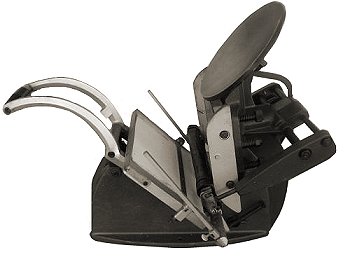
An Adana Eight Five printing
machine. |
|
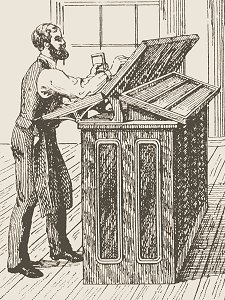
A typesetter at work. |
After leaving school, John went
on a printing course at Wolverhampton College of Art,
which at that time was in the basement of the Art
Gallery. When the three year, full-time course ended he
ran his own printing business, working in a garden shed
at the back of number 97. He managed to make a living,
thanks to regular jobs that came his way and remembers
printing tickets for a local children’s party, held to
celebrate the 1953 coronation. He also printed large
numbers of labels for Reade Brothers, the manufacturing
chemists. Meanwhile Norman
Robinson and Ken Fellows moved their printing business
out of number 70A, and the property owner Chris Hill,
used the now vacant premises to sell washing machine
parts and such things as wooden mangle rollers. John’s
business continued to thrive and by 1971 he had made
enough money to rent the shop from Mr. Hill and he moved
the business into what would become its future home.
|
| In 1973 Mr. Hill asked John if he
wanted to buy the shop and the house next door, and this
he did. John’s business remained in the same premises
for the rest of his life.
John was ably assisted by Bill Howe who specialised in producing the pre-press
work for their litho printers. |
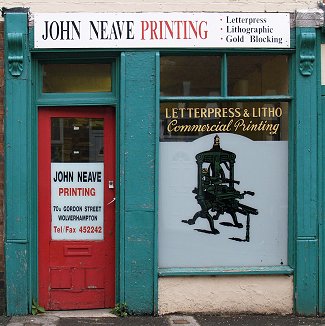
Number 70A Gordon Street. |
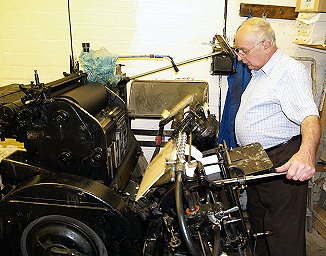
John keeping an eye on one of his
Heidelberg printing machines. |
Over the years John has worked
for many well-known local businesses and organisations,
some of whom are long-gone.
One of his customers has been The
Midland Metal Spinning Company Limited, who were in
Wolverhampton and Wombourne. They produced domestic
metalware using the Presto and Tower Brand names. In the
past John has received large orders from them, for such
things as 500,000 inspection complaint slips. The order
for them arrived on a Thursday and they wanted the first
100,000 by the following Monday, which resulted in a
hard weekend’s work. |
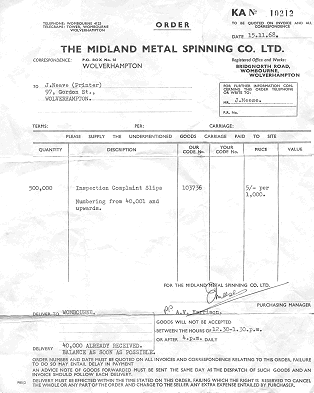
John's order for 500,000 inspection
complaint slips.
| Another order from the same
company demonstrates John’s extreme versatility. He
produced 30,000 self-adhesive labels for use on their
Teasmaids.
The labels were individually cut
so that each one could be peeled from the backing and
easily applied to the product. The Teasmaids were sold
in America to help promote tea drinking. |
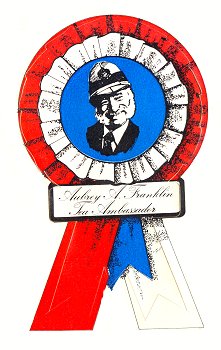
One of the Teasmaid labels. |
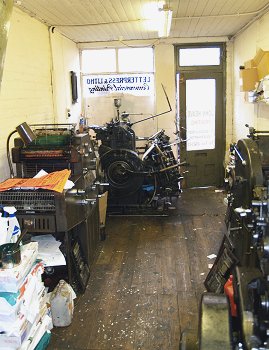
The front of John's shop. In the
centre is the 1963 Heidelberg
machine, and on the left and right are his litho
machines. |
A famous name from
Wolverhampton’s past is Reade Brothers and over the
years John produced hundreds of thousands of bottle
labels for them. One of their products was quarter pound
tubs of bicarbonate of soda that were supplied in large
quantities to Cadbury’s. John used to print the labels
for them. He also produced
work for Chance Brothers of Birmingham. One of John’s
long-standing customers was the Wombourne Players,
originally called the Dunstall Players. John began
printing for them in 1956. |
| John’s main workhorses were his
two Heidelberg printing machines and two A3 litho
machines. One of the Heidelbergs dates from 1953 and the
other from 1963. They are amazing machines and
were commonly used by the jobbing printer.
They not only print, but can emboss,
cut, perforate, and print automatically incremented
numbers. The machines can also handle paper in many
shapes and sizes. John’s specialty was to use them for
producing individually numbered and perforated draw
tickets for churches, societies and charities, that were
supplied as small books. Orders varied from a few
thousand up to 100,000 and often had to meet tight deadlines. |
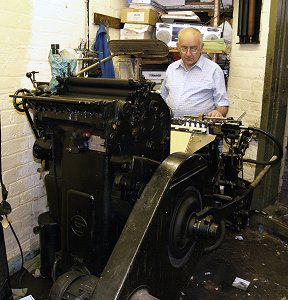
John at work on his 1953
Heidelberg machine. |
|
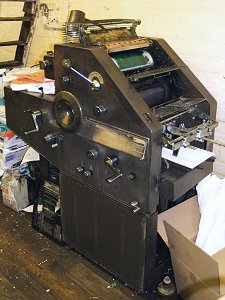 |
One of John's two litho
machines. |
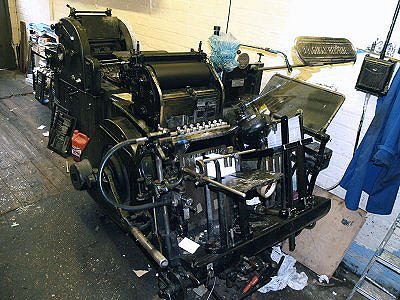
John's 1953 Heidelberg
machine.
| John was an experienced hand
typesetter and had what must have been one of the
region’s largest collections of type, in many typefaces
and styles. He collected it over many years, often from
old companies when they ceased trading.
Some of his type dates back to a time before the modern
point system was introduced in the early 1890s. In those
days names such as diamond and pearl were used for
different sizes of text. |

John examining some of his early
type. |
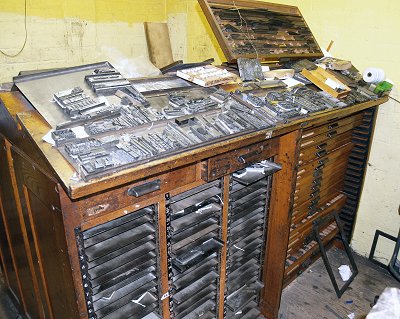
Drawers of type in the typesetting room.

Assembled type ready for use.
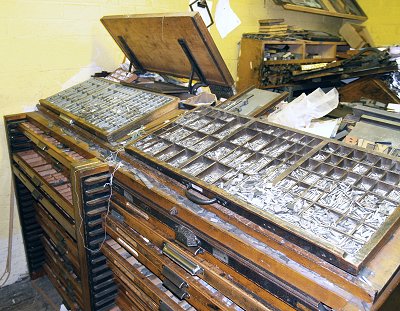
More of John's type cabinets.
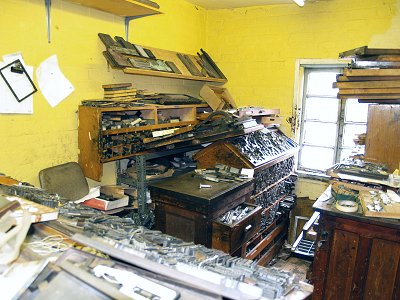
Another corner of the type room.
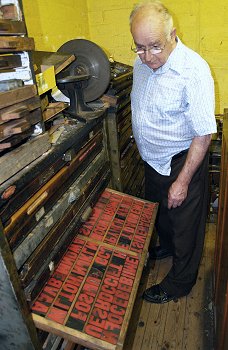
John looking at some of his wooden type.
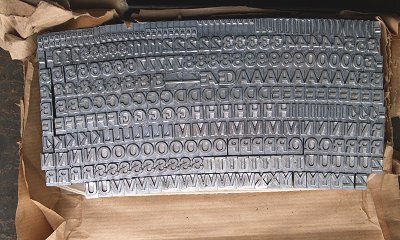
A freshly opened packet of 24 point Universe
Bold type.
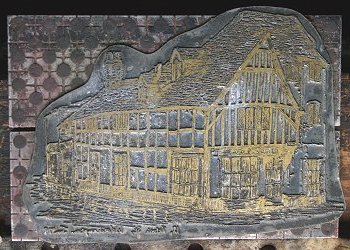
One of John's plates portraying a
scene that's familiar to most Wulfrunians; Lindy Lou's
in Victoria Street. |
John also had a collection of
engraved plates, some of which are very old. He used
many of them for jobs in the past and some of them
feature names of well-known and long-gone Wolverhampton
companies.
John’s oldest machine, was
an F/F Arab Platen printing machine that
dates from 1895. John fully restored the machine and
even ran it from an electric motor. He used the
machine for special jobs and it worked very well, the
only disadvantage was that it is hand-fed. |
| Another plate portraying the
Greyhound and Punchbowl in Bilston. |
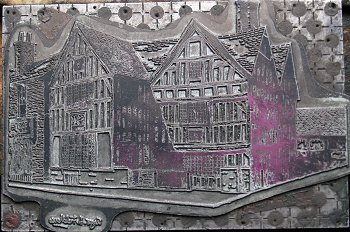 |
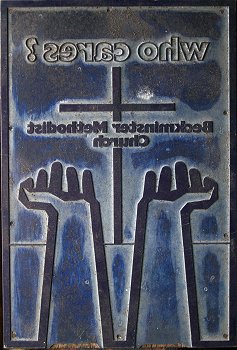 |
One of John's plates and what
it produces. |
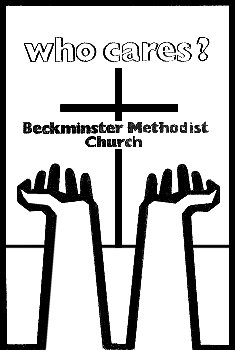 |
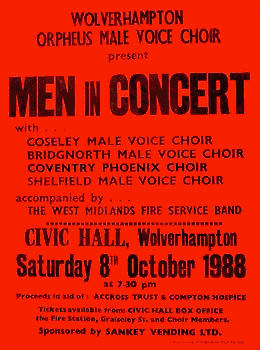
A large poster printed by John.
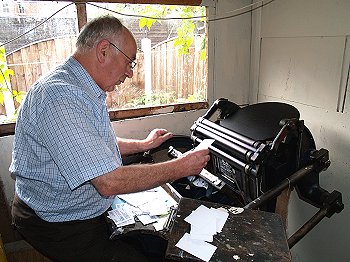
John using his F/F Arab
Platen printing machine from 1895.
|
Printing had
been done at John’s premises since 1948 and John himself
had been in business since 1949. In 2023 he celebrated
his 74th year as a printer and had no intention of
retiring for some time. His business was very successful, and
John was as enthusiastic as ever about all aspects of the
trade. Sadly John died in September 2024.
|
|
 |
|
Return to the
Printing Hall |
|